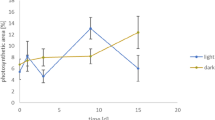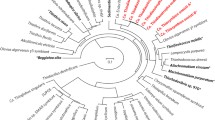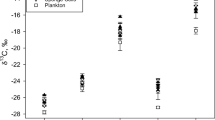Abstract
The marine, free-living Stilbonematinae (Nematoda: Desmodoridae) are remarkable for the ectosymbiotic, prokaryotic microorganisms that populate their entire body surface. These nematodes occur in sulfidic sediments in the microoxic zone just above the sulfide maximum. Several facts point to a chemolithotrophic, sulfide oxidizing nature of the microorganisms. The oxygen uptake of three species was measured with and without their microbial coat using Cartesian and Gradient Diver microrespirometry in February 1989 at Carrie Bow Cay (Belize Barrier Reef). Symbiont-free stilbonematids exhibited constant and uniform oxygen uptake rates over several hours; rates which are significantly lower than those of oxyphilic nematodes. Freshly extracted stilbonematids, with intact bacterial coats, consumed significantly more oxygen than symbiont-free worms in the first 3 h of measurement. While the rates of aposymbiotic worms were more or less constant over time, the rates of symbiont-carrying worms exhibited a conspicuous drop during prolonged respiration. InStilbonema sp., symbiont carrying individuals kept under oxygenated conditions for more than 12 h had a respiration rate similar to those of aposymbiotic specimens. When such worms were re-incubated in sulfide-enriched seawater the respiration rate was significantly elevated. The possibility of “recharging” the oxygenated symbiosis system via sulfide-uptake is seen as an indication that storage of reduced sulfur compounds, or reserve substances synthetized in the presence of sulfide, play a decisive role in the metabolisms of the symbiotic bacteria. Migration of nematodes between sulfidic and oxidized sediment-layers are, most likely, the key to understanding the success of this nematode-bacteria symbiosis.
Similar content being viewed by others
Literature cited
Boaden, P. (1974). Three new thiobiotic gastrotrichs. Cah. Biol. mar. 15: 367–378
Boaden, P. (1975). Anaerobiosis, meiofauna and early metazoan evolution. Zool. Scr. 4: 21–24
Childress, J. J., Mickel, T. J. (1982). Oxygen and sulfide consumption rates of the vent clamCalyptogenia pacifica. Mar. Biol. Lett. 3: 73–79
Dando, P. R., Southward, A. J., Southward, E. C. (1986). Chemoautotrophic symbionts in the gills of the bivalve molluscLucinoma borealis and the sediment chemistry of its habitat. Proc. R. Soc. (Ser. B) 227: 227–247
Fenchel, T., Finlay, B. J. (1989).Kentrophoros: A mouthless ciliate with a symbiotic kitchen garden. Ophelia 30: 75–93
Giere, O., Wirsen, C. O., Schmidt, C., Jannasch, H. W. (1988). Contrasting effects of sulfide and thiosulfate on symbiotic CO2-assimilation ofPhallodrilus leukodermatus (Annelida). Mar. Biol. 97: 413–419
Hamburger, K. (1981). A gradient diver for measurement of respiration in individual organisms from the micro- and meiofauna. Mar. Biol. 61: 179–183
Hammen, C. S., Osborne, P. J. (1959). Carbon dioxide fixation in marine invertebrates: a survey of major phyla. Science, N. Y. 130: 1409–1410
Jannasch, H. W., Wirsen, C. O. (1985). The biochemical versatility of chemosynthetic bacteria at deep-sea hydrothermal vents. Bull. biol. Soc. Wash. 6: 325–334
Jensen, P. (1986). Nematode fauna in the sulphide-rich brine seep and adjacent bottoms of the East Flower Garden, NW Gulf of Mexico. Mar. Biol. 92: 489–502
Jensen, P. (1987a). Feeding ecology of free-living aquatic nematodes. Mar. Ecol. Prog. Ser. 35: 187–196
Jensen, P. (1987b). Differences in microhabitat, abundance, biomass and body size between oxybiotic and thiobiotic freeliving marine nematodes. Oecologia 71: 564–567
Kelly, P. D. (1982). Biochemistry of the chemolithotrophic oxidation of inorganic sulphur. Phil. Trans. R. Soc. (Ser. B) 298: 473–497
Klekowski, R. Z. (1971). Cartesian diver respirometry for aquatic animals. Polskie Archwm. Hydrobiol. 18: 93–114
Klekowski, R. Z., Schiemer, F., Duncan, A. (1980). Ampulla gradient diver microrespirometry. Ekol. Pol. 28 (4): 675–683
Kuenen, J. G., Beudeker, R. F. (1982). Microbiology of thiobacilli and other sulphur oxidizing autotrophs, mixotrophs and heterotrophs. Phil. Trans. R. Soc. (Ser. B) 298: 473–497
Lasserre, P. (1976). Metabolic activities of benthic microfauna and meiofauna: recent advances and review of suitable methods of analysis. In: Mac Cave, I. N. (ed.) The benthic boundary layer. Plenum, New York, p. 95–142
Lovlie, A., Zeuthen, E. (1962). The gradient diver — a recording instrument for gasometric micro-analysis. Compt. Rend. Trav. Lab. Carlsberg 32(31): 512–534
Nexø, B. A., Hamburger, K., Zeuthen, E. (1972). Simplified microgasometry with gradient divers. Compt. Rend. Trav. Lab. Carlsberg 39(4): 33–63
Ott, J. A. (1972). Determination of fauna boundaries of nematodes in an intertidal sand flat. Int. Revue ges. Hydrobiol. 57(4): 645–663
Ott, J. A., Novak, R. (1989). Living at an interface: Meiofauna at the oxygen/sulfide boundary of marine sediments. In: Ryland, J. S., Tyler, P. A. (eds.). Reproduction, genetics and distribution of marine organisms. Olsen & Olsen, Fredensborg, p. 415–422
Ott, J. A., Rieger, G., Rieger, R., Enderes, F. (1982). New mouthless interstitial worms from the sulfide system: symbiosis with prokaryotes. Pubbl. Staz. zool. Napoli (I: Mar. Ecol.) 3(4): 313–333
Ott, J. A., Schiemer, F. (1973). Respiration and anaerobiosis of free living nematodes from marine and limnic sediments. Neth. J. Sea Res. 7: 233–243
Powell, E. N., Crenshaw, M. A., Rieger, R. M. (1979). Adaptation to sulfide in the meiofauna of the sulfide system. I.35S-sulfide accumulation and the presence of a sulfide detoxification system. J. exp. mar. Biol. Ecol. 37: 57–76
Riemann, F., Schrage, M. (1988). Carbon dioxide as an attractant for the free-living marine nematodeAdoncholaimus thalassophygas. Mar. Biol. 98: 81–95
Schiemer, F. (1987). Nematoda. In: Pandian, T. J., Vernberg, F. J. (eds.). Animal energetics, Vol. 1. Academic Press, New York, p. 185–215
Schiemer, F., Duncan, A. (1974). The oxygen consumption of a freshwater benthic nematodeTobrilus gracilis (Bastian). Oecologia 15: 212–216
Southward, E. C. (1986). Gill symbionts in thyasirids and other bivalve mollusca. J. mar. biol. Ass. U.K. 66: 889–914
Steudel, R. (1989). On the nature of the “elemental sulfur” (S°) produced by sulfur-oxidizing bacteria — a model for S° globules. In: Schlegel, H. G., Bowien, B. (eds.). Biology of autotrophic bacteria. Science Tech. Publ., Madison, p. 193–217
Vetter, R. D. (1985). Elemental sulfur in the gills of three species of clams containing chemoautotrophic symbiotic bacteria: a possible inorganic energy storage compound. Mar. Biol. 88: 33–42
Wieser, W. (1959). Eine ungewöhnliche Assoziation zwischen Blaualgen und freilebenden marinen Nematoden. Österr. bot. Zeitschr. 106: 81–87
Wieser, W. (1960). Benthic studies in Buzzards Bay II. The meiofauna. Limnol. Oceanogr. 5: 121–137
Wieser, W. (1975). Meiofauna as a tool in the study of sediment heterogeneity: ecophysiological aspects. A review. Cah. Biol. Mar. 16: 647–670
Wieser, W., Ott, J. A., Schiemer, F., Gnaiger, E. (1974). An ecophysiological study of some meiofauna species inhabiting a sandy beach at Bermuda. Mar. Biol. 26: 248–253
Zeuthen, E. (1950). Cartesian diver microrespirometer. Biol. Bull. mar. biol. Lab., Woods Hole 48(2): 139–143
Author information
Authors and Affiliations
Additional information
Communicated by O. Kinne, Oldendorf/Luhe
Please address all correspondence and requests for reprints to Professor J. Ott
Rights and permissions
About this article
Cite this article
Schiemer, F., Novak, R. & Ott, J. Metabolic studies on thiobiotic free-living nematodes and their symbiotic microorganisms. Mar. Biol. 106, 129–137 (1990). https://doi.org/10.1007/BF02114683
Accepted:
Issue Date:
DOI: https://doi.org/10.1007/BF02114683




